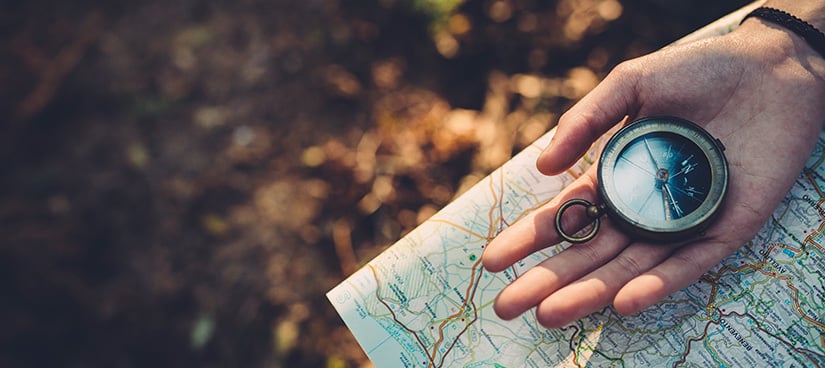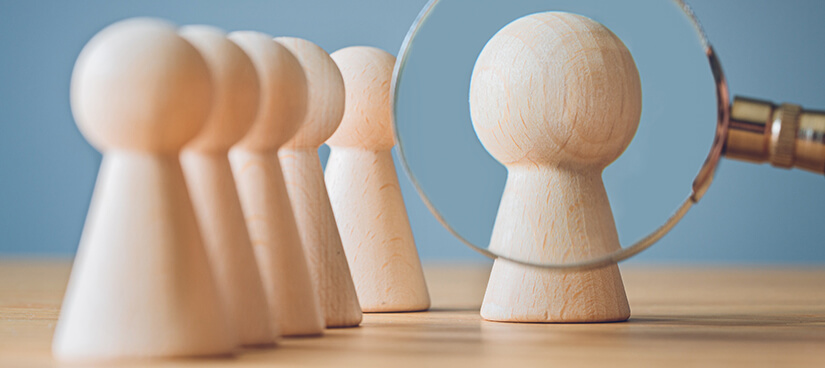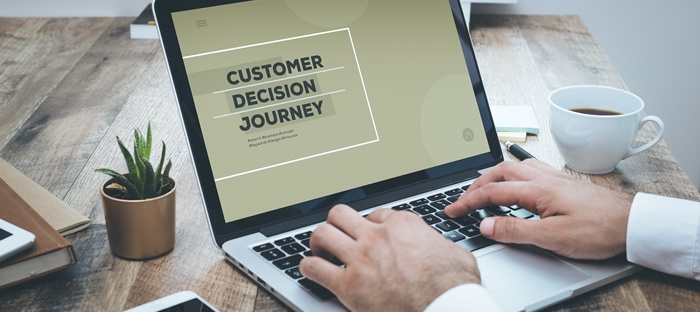Buyer Journey Mapping in 7 Easy Steps [EXAMPLES + TEMPLATE]

Editor’s Note: This blog post was originally written by Christina Bockisch and published in 2018. We have refreshed and updated the post to include more helpful examples!
I had just moved to Boston. In November. My legs were freezing, cold air was whistling up the back of my jacket and I couldn’t stop shivering.
I recognized I had a problem, so I turned to Google to do some research. I read a couple of articles and browsed some different styles of jackets. Soon I realized the best solution for me was a parka, instead of the warm-but-too-short jacket I currently had. So, I braved the Boston cold, went to multiple stores all over the city, and found a thick The North Face parka that saved me from freezing.
In other words, I completed my buyer’s journey.
In the story above, my buyer’s journey began the moment I realized I had a problem: I’m cold. I then went on to define my problem: My short jacket doesn’t keep my legs warm enough. Next, I identified a solution: I need a parka. And finally, I chose the right brand to solve my problem: The North Face.
It’s a simple example, sure. But whether you’re selling something as straightforward as winter jackets or as complex as SAP cybersecurity software, it’s important to understand how your potential customers think about their pain points as they move through this buyer’s journey and make their buying decision. This enables you to create content that directly aligns to each stage in that journey, which in turn enables you to deliver a far superior customer experience. And yet, it’s surprising how many B2B marketers ignore the buyer’s journey in their content strategy process.
What is the buyer’s journey?
The buyer’s journey describes the process your buyers go through as they become aware of a problem, evaluate potential solutions to their problem, and ultimately decide on the specific solution that’s right for them.
In marketing terms, we think of these stages of the buyer’s journey as:
- Awareness stage
- Consideration stage
- Decision stage
Awareness Stage
In the awareness stage, a person is experiencing symptoms of their pain point, but they don’t quite understand exactly what their problem is. Their goal at this stage is to help your customer more clearly define the problem they’re experiencing.
Examples:
- I have a sore throat. Am I getting sick?
- I’m not getting enough traffic to my website. Why?
- Our production machinery is getting old. Is it time to replace it?
To create content that helps buyers in the awareness stage, focus on addressing pain points, challenges and goals at a relatively high level. Make sure the content is informative and resist the urge to start selling the buyer on your particular solution to their problem. Keep it low pressure.
Useful content like guides, blog posts, infographics, and quizzes will help your buyers wrap their heads around their pain points, so they can figure out what their next step should be.
Consideration Stage
In the consideration stage, the person understands what the problem is and begins researching possible solutions.
Examples:
- I have all the symptoms of strep throat. Should I see a doctor, or should I try a home remedy?
- My website is not properly optimized for search engines. Would it help to start a blog?
- We should begin planning now to replace our machinery next year. What features of a new model will be important for us?
Businesses often struggle with creating consideration stage content because it feels like the right time to start promoting your business as the best solution. Don’t! Instead, the consideration stage is the perfect opportunity to serve up in-depth content that acknowledges different approaches that could possibly work for the buyer. Among these options, you can still (subtly) position your company as the best solution.
Consideration-stage content is also a terrific way to identify potential good-fit leads – the buyers who are right for your business and can benefit from product or service you sell.
Decision Stage
In the decision stage, the person has settled on a specific approach and is putting together a short list of vendors to possibly buy from. Their goal here is to narrow down that list and ultimately make a final buying decision.
Examples:
- I think I should go to urgent care. Here are the urgent care centers near me that also accept my insurance.
- I would like to blog, but I need help. Here is a list of three agencies that might be a good fit for me.
- We need better production automation capabilities. Here are the models on the market today that offer what we need.
With decision-stage content, you can finally openly promote your product or service. Show how you solve your buyer’s problems and explain why your option is the best approach. Be honest yet humble, and wherever possible back up any claims with data. For example, rather than unprovable statements like “We are the best in the market,” instead try to be more specific: “We have a 4.9 out of 5 rating on this industry site” or “We helped Company XYZ grow by 50% last year.”
Data sheets, comparison blog posts, case studies, ROI calculators, and buying guides are powerful content for the decision stage.
An important note about the buyer’s journey stages
In an ideal world, every person would move through the buyer’s journey exactly the way I described above – in a straight line from awareness to consideration to decision. And as they move through that journey, they’d have all the information they needed to make a purchase decision once they arrive at the decision stage.
Unfortunately, real life is rarely so neat and tidy.
People today don’t always move through this journey in a linear fashion. Buyers are human. They’ll jump around, skip stages, and sometimes go backwards rather than forward. They can even get all the way to the decision stage only to realize they misidentified their pain point, which means they have to start the whole buying journey process all over again.
Your job as a marketer is to plan for as many of these situations as possible. The best way to do this is to create a content strategy that covers all the stages of the buyer’s journey. This will ensure that no matter where someone is in their specific journey, when they find your brand, they’ll find all the information they need to make an informed buying decision.
Related Content: Content With Purpose: How to Align Content to the Buyer’s Journey
7 steps for mapping the buyer’s journey
Now that you have a better understanding of what the buyer’s journey is, here is a helpful buyer journey framework for you to follow when building your content strategy.
1. Define your buyer personas.
I think I say this every time I write a blog, but if you haven’t already created your buyer personas, stop what you’re doing and create them now. Seriously.
If you don’t know who your buyers are – and specifically if you don’t know your buyer persona’s challenges, questions, and goals they’re trying to accomplish – you’ll have a hard time creating a buyer journey map and accurately aligning your content to that journey.
For guidance on getting started with buyer personas, check out this post that highlights specific questions to ask during buyer persona interviews.
These sample buyer persona templates may also be helpful.
Okay, so let’s assume you have your buyer personas fully identified and documented. Now you’re ready to start building your journey map.
2. What are your most important buyer persona challenges?
To map the awareness stage of the buyer’s journey, first, identify the obstacles and problems that prevent your buyer from accomplishing their goals.
Next, think about how your buyer first begins to realize this obstacle or problem even exists. What challenges begin to emerge? What concerns do they begin to have? What puts this on their radar?
There will be a lot to think about here, so write it all down. (Side note: Now would be a good time to download the Buyer’s Journey Toolkit we provided above. Trust me, it’ll help tremendously.)
3. What are all the possible solutions to these problems?
To map the consideration stage of the buying journey, think about the different approaches your buyer might consider as they try to figure out how to solve their problem. After all, there’s usually more than one way to skin a cat. Is there a do-it-yourself approach? Are there off-the-shelf solutions? Or does the problem require something more specialized or customized?
As the buyer explores these different solutions, what questions will be top of mind for them? What concerns will they likely have?
4. What other companies offer your type of solution?
To map the decision stage of the buying journey, list the other companies that offer a type of solution comparable to yours. (I’ll admit that thinking about your competitors is no fun, but it needs to be done.)
What questions will your buyer have when they vet each of these competitors? How will they evaluate these options? Which features will be most important to their decision?
For example: Your buyer might quickly cross “do nothing” off the list. But they’ll also probably look closely at all their software options, looking at things like cost, functionality, and ease of use. They might conduct a few demos to get a feel for how the different software options work.
Similarly, they might start building a short list of IT service providers. They might look for case studies to see how the different service providers work. And they might even contact you for a consultation to see if you’d be a good fit for them.
5. Identify points of friction along the buyer’s journey.
Whew – you’ve mapped out the awareness, consideration and decision stages of the buyer’s journey. Congratulations! But your work isn’t done quite yet.
What might prevent the buyer from moving smoothly from one stage to the next? What challenges do they encounter during their journey? What might cause them to move backward? What might prevent them from making a purchasing decision?
And what can you do to ensure this doesn’t happen and that you’re providing the smoothest customer experience possible?
This is going to require you to think hard about what your buyers are actually doing rather than what you hope they’re doing. But by identifying these possible points of friction that might prevent a buyer from becoming a customer, you’ll be able to create content that truly helps and sells.
6. How does your existing content fit into this buyer’s journey?
You likely already have some content on your website, like blogs, ebooks, guides, consultations and more. Audit your existing content, and think about where each piece falls in in this customer experience map. Which content addresses pain points and challenges at a high level? Which content is focused on specific solutions? Which content proactively sells your business as the right partner?
Don’t rush through this step.
Once you have a good handle on what role your content can play, map each piece of content to the corresponding stage of the buyer’s journey.
7. Create new content to fill in the gaps.
Now that you know where your existing content fits into the buyer’s journey, identify any gaps. Many B2B marketers find they have a lot of awareness-stage and decision-stage content but that they don’t have enough consideration-stage content. Don’t stress – this is totally normal.
As you strategize how to fill in these content gaps, we recommend starting at the end of the buyer’s journey and moving backward. In other words, first create your decision-stage content, then consideration, and then awareness. This accomplishes two things: First, it helps you keep your eye focused on converting buyers into customers. And second, it ensures that for every new content piece you create, you already have a “next step” to point to.
For example, if you first create a decision-stage vendor comparison checklist and then you create a consideration-stage ebook, when a buyer downloads the ebook you're able to share your vendor comparison checklist with the buyer as a natural next step. But if you start by creating the ebook, you won’t have any next-step content ready to share with those buyers.
As you’re creating all this new content, continually refer back to your buyer journey map. Make sure each piece of content addresses the specific questions, challenges, and goals your buyers have at each stage of the game.
When you do this, you’ll provide helpful, valuable and relevant information that provides your buyers with the information they need when they need it and reduces friction along the way – ultimately leading to happy, satisfied customers who will turn into promoters of your brand.
Now that you know what the buyer’s journey looks like for your customers, it’s time to create content for each stage of this journey. Download our free editorial calendar template and start planning your content today!





